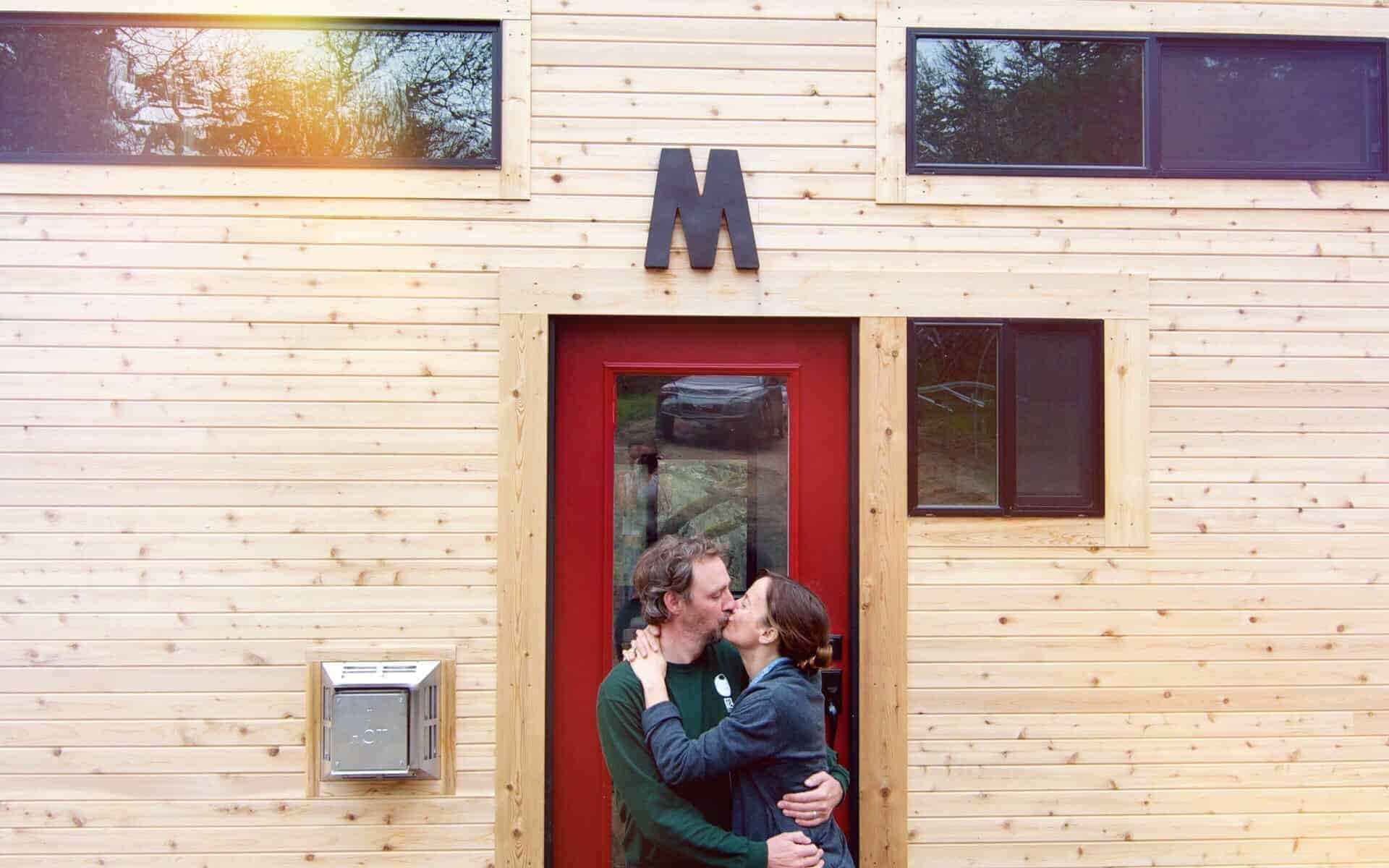

Want to convince your spouse or family of the benefits of living in a Tiny House? This interview is full of information to help make a case for going Tiny.
This week I had the opportunity to exchange messages with Gabriella and Andrew Morrison of Tiny House Build, the architects behind the “hOMe” Tiny House design, and a family of four living Tiny.
I wanted to learn more about their journey, some specifics of Tiny House living, and the effect it’s had on their family life.
The Morrison’s live completely off-grid (with the exception of propane), their Tiny House design is one of few with a full stairwell (great for dogs), and I asked them a ton of technical questions toward the end. Enjoy!
Personal Questions
In order for interested Tiny House proponents to cut through all the hype surrounding the phenomenon at present, I tried to make my line of questioning as thorough as possible. We began with tackling the mindset behind their life-changing decision to live Tiny;
1. What made you decide to build your own Tiny House design from scratch?
Though there are some great tiny house plans on the market, ultimately we decided to create a custom set of plans for ourselves to meet our specific needs.
We named our tiny house design “hOMe” because it breathes tranquility and peace of mind for us. The hOMe plans are available for purchase for others that are interested in them.
2. What was it about Tiny Houses that attracted you to this way of living, and what events led up to it?
We were introduced to the tiny house movement by Kent Griswold of Tiny House Blog about four years ago. Right around that time we were living in our ‘dream’ home.
It was large, beautiful, and was supposed to represent our ‘success’ in life. Problem was that after 6 months of living in it we realized that we had become slaves (slaves to paying for it, cleaning and maintaining it). Our family dynamic suffered as we had to say “no” to the kids so much to work, and we all kind of just scattered to various corners of the house.
The American Dream had turned into a nightmare.
3. How did your family deal with the proposition of living in a Tiny House?
Once we were introduced to the tiny house movement and fell in love with it, things moved very quickly.
In 6 months we had gotten rid of 90% of our material possessions, gotten rid of the house, bought a pop up tent trailer, and moved to the beaches of Baja for 5 months with our 10 year old daughter (while) our son went to school in Colorado to follow his passion and play ice hockey.
Mind you that at this time the tiny house movement hadn’t received as much press as it has now so the general public really hadn’t been introduced to the concept. Friends and family were supportive but definitely concerned about the reasons for us making such a big change.
It was difficult for them to understand why we would leave that gorgeous house and get rid of most of our material possessions. I think they were worried that we would regret our decision.
4. What were the biggest obstacles you had to overcome before moving into a Tiny House?
Making the move into hOMe was actually a multi-year and multi-step process.
First came our initial downsizing, then moving to the beaches of Baja to “disconnect” from day to day stresses with the goal of rediscovering who we were without those pressures, then came reintegrating back into US life and culture (while retaining the gifts and changes we had embodied in Baja).
Then renting two houses while we came up with our action plan. Finally purchasing our 5 acres to build our tiny house on.
Our biggest obstacle was our minds: We had to get clear on what was important (and what wasn’t!) and in order to do that we really had to break away from all that we had been taught about material possessions, housing, success and priorities.
That trip to Baja really changed everything and in those months we developed a clear understanding of who we are and what brings us joy. After that point, it was all pretty simple because we had an action plan and vision set up for ourselves. It was just a matter of moving the pieces around in our lives until our vision was a reality.
5. How has living in a Tiny House affected the quality of life for you, your family, and your relationship to one another?
Having lived in two extreme situations (very large house to tiny house) I can say with total clarity that living tiny is much better for our family dynamic.
There is a closeness to our family dynamic now that we didn’t always have. Our communication skills have increased dramatically and our desire to spend time together has gone way up.
Living tiny has also been the most wonderful motivator to practice mindfulness and to exercise the best self care possible.
With the time we would normally have spent cleaning and working to pay for our housing costs, we are now able to do the things we had always just dreamed of such as sticking to a regular exercise program, eating extremely healthy food, traveling more, etc.
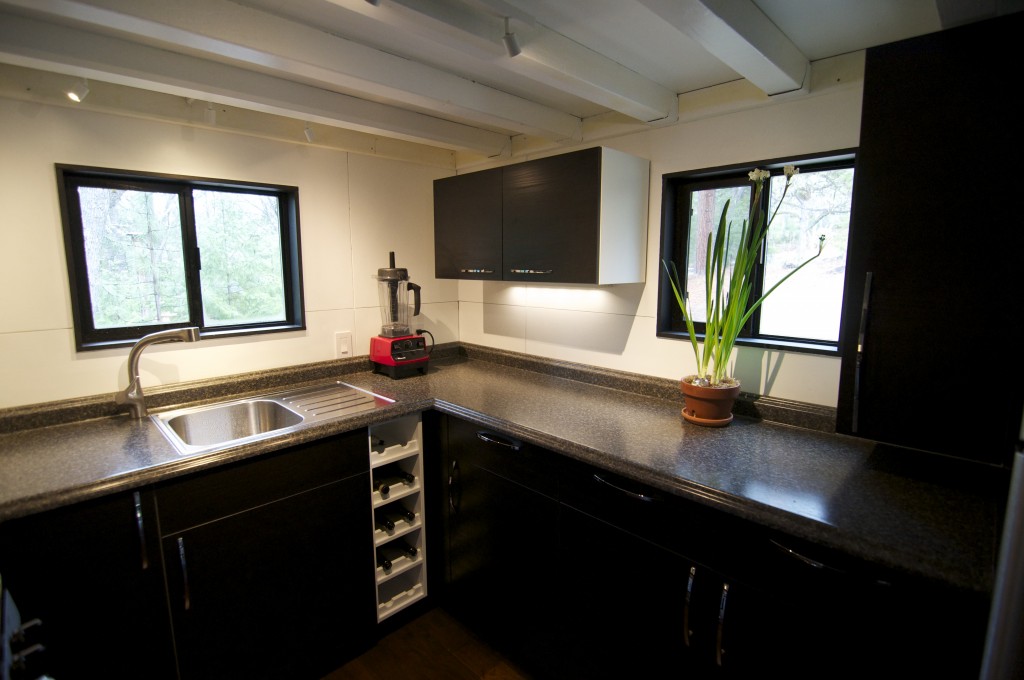
6. Let’s talk about failure; Tell me about a time during your Tiny House journey where you failed.
About half way through our build, our region was hit with a long lasting cold spell that brought rain, sleet, snow, wind and very few sunny and warm days.
At this time we were living on our property out of our pop up tent trailer with a barely functioning heater. We had no hot running water and basic living necessities became a challenge.
We entered a state of feeling perpetually cold, wet, and depleted. Our communication broke down and there were about three weeks in which we felt tempted to abandon the whole build.
After the third week we realized that we needed to change something and we took up a dear friend’s offer for us to come and stay at their very warm and very dry house in the evenings. Though we had been adamant that we would stay on site for the whole build, we had to reassess and take a stand for our sanity.
Sometimes there is a need for flexibility and the ability to change plans for a better end result.
7. Now, let’s talk about success; What was the story, process, or “Tiny House eureka moment” that brought you to this success?
My biggest moment of joy and pride in hOMe was the very first night that we moved in.
It was an exceptionally cold evening and the temps were to go down to -10F. We had just installed our heater and turned it on and though our house still had three weeks left of work to be completed, we simply couldn’t wait another day to move in.
I had one of the best nights of sleep that night and the house had absolutely zero issues staying warm, despite the extreme temperatures. Opening my eyes the next morning in the house that we had been envisioning for years was a moment I’ll never forget.
Personal Preferences
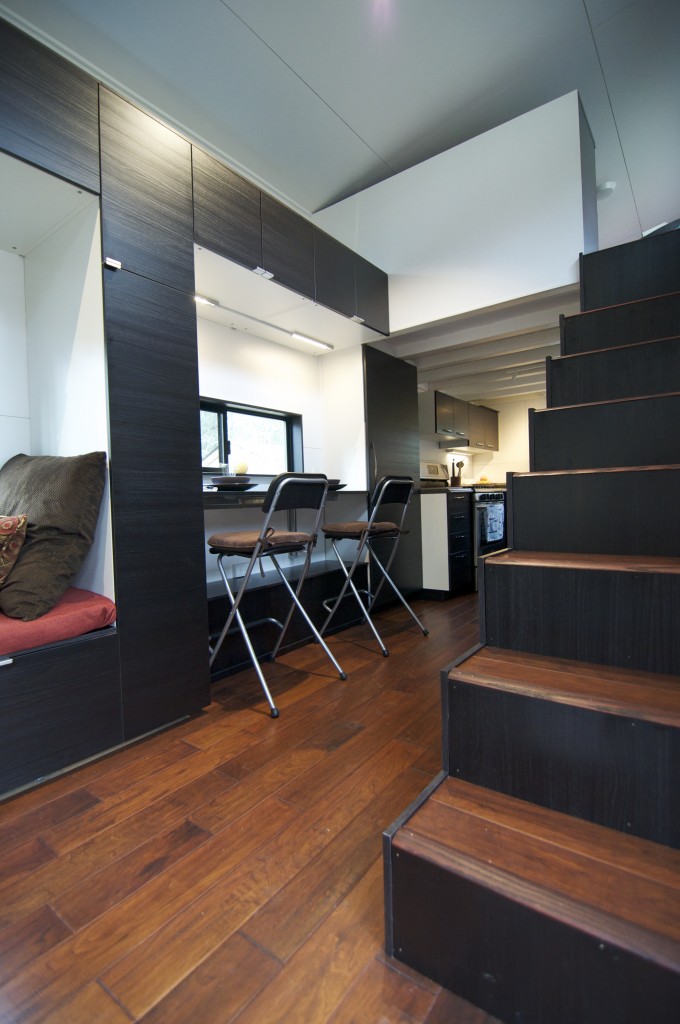
8. Stairs/ladder, or no stairs/ladder?
We have both and can tell you that in going up both each day, the stairs win, hands down.
Our stairs are so easy to get up and down and because they double duty with providing 25 square feet of storage below; it’s a perfect marriage.
Plus, Oscar, our beloved dog can get up to our master loft via the stairs and we wouldn’t have it any other way.
9. How many square feet do you think is ideal for a couple?
For a tiny house to meet the long term needs of a couple, we recommend 200 square feet (not including lofts).
This is about what we have for hOMe, and it is a beautiful size in that it allows plenty of space for each of us so that we don’t feel like we are tripping on each other.
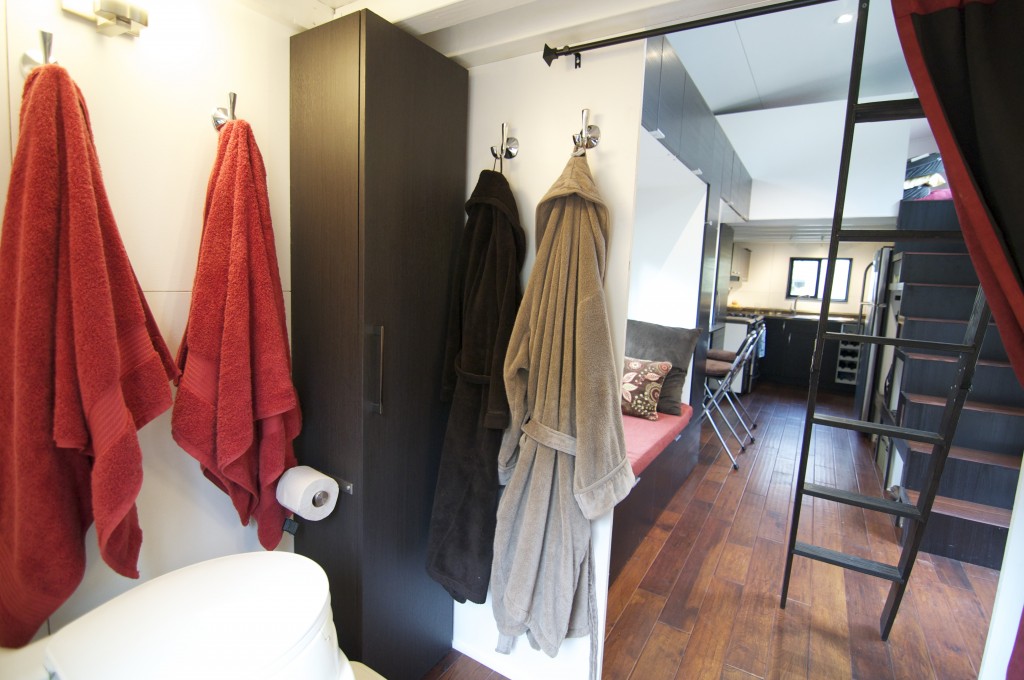
10. How many square feet do you think is ideal for a family of 4?
For a family of 4 we would recommend 400 square feet. The challenge with living with two kids under the same roof is the sleeping arrangements as well as individual space.
Coming up with a tiny-house-on-wheels design for a family of 4 has still not successfully been done in our view.
What we have set up on our 5 acres is hOMe of course, as well as a cabin for each of the two kids that are situated very closely to hOMe, which is base. That really is the hub of activity for us all and it is the place with kitchen and bathroom, etc.
At night the kids sleep in their own place for the most part and they also do schoolwork in them (our daughter is homeschooled) as well as their art, music, etc.
Because they are both independent but also love to spend time together as a family, it works out really well for our family dynamic. This may not be a great set up for families where the kids want to escape from family so it needs to be assessed on a case by case basis.
Climate
11. What are some key concerns to consider for a Tiny House in colder climate from those in warmer climate?
- Potential for condensation issues. Making sure that vapour barriers and house wrap products are used properly and installed per manufacturer recommendations for the climate in which they are used. Cold air infiltration and warm air infiltration create different impacts on a house.
- Passive solar gain. Be sure to maximize solar access and proper solar sharing during winter and summer months. Hot climates require more attention to shading and cross breezes than cooler climates. Conversely, tiny houses in cooler climates need to focus on solar gain for passive heating.
- Mechanical systems. Cold climates require heating systems with adequate BTU ratings. Hot climates need to focus on cooling systems that provide adequate BTUs without over-taxing the electrical system. Climates that experience both the heat and cold need to consider systems that can manage both heating and cooling. A big issue is making sure you calculate the BTU requirements properly and then size your system(s) accordingly.
12. What type of insulation would you suggest for warmer climate?
hOMe is parked in the shade of two large oak trees which provide shade on our hot summer days, and all of the cooling we need (even on 100F days).
If one has a grid tied power source, we recommend a mini split heating/cooling system. They are small and very efficient and can perform both of those tasks.
Curtains are an easy solution for keeping hot sun out of a tiny house if shade doesn’t exist.
13. What type of insulation would you suggest for colder climate?
For truly cold climates one would want to beef up their framing members to be able to install thicker insulation. A size appropriate and reliable heater is a must.
In terms of what insulation to use, rigid is a good way to go. One’s best resource is their local building department to ask what requirements are to meet R Value codes and how they recommend one go about that. Also, connecting with local RV shops is a fantastic way to find out how to keep water lines from freezing in that area.
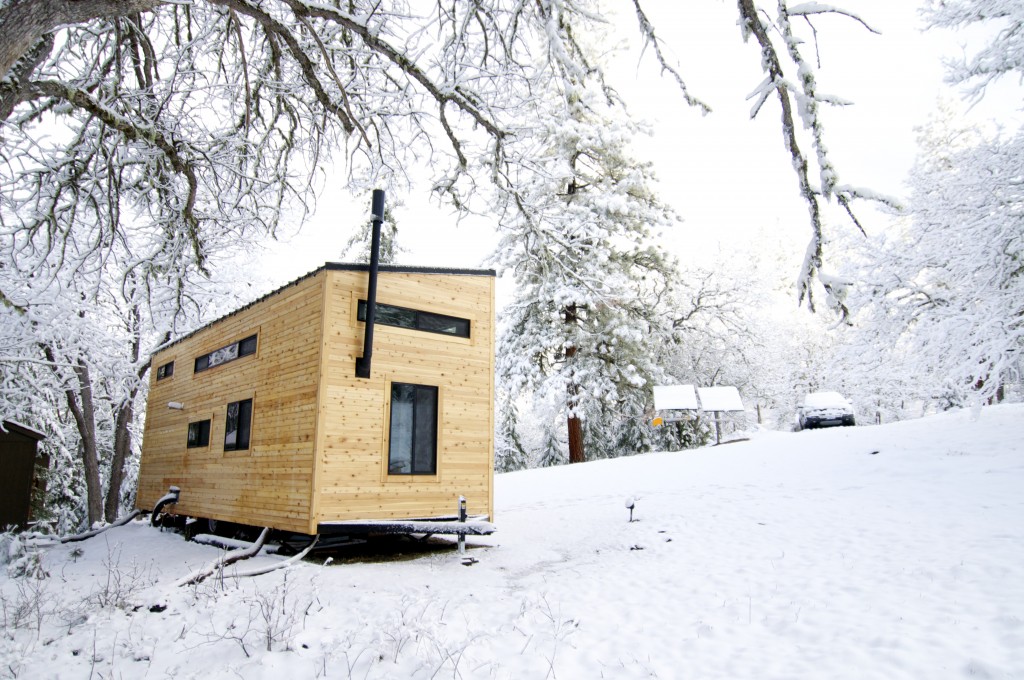
14. Do you have any thoughts, tips, or advice for dealing with extreme weather, such as hurricanes or earthquakes?
Our hOMe plans are designed/engineered with tie down solutions to be able to withstand hurricane strength winds. It’s important to be able to secure your tiny house to the ground if you live in an area with potentially high winds. If one is in the line of a hurricane, they may want to move their tiny house into a safety zone.
In terms of earthquakes, Tiny Houses do pretty well in them because the houses are able to sway with the waves.
Components
Living in a Tiny House is still a relatively new phenomenon, and its smaller size tends to create problems when it comes to pre-fabricated appliances, fixtures, and furnishings.
15. What items for your Tiny House required custom handiwork, and which items were purchased pre-fabricated?
We went with IKEA cabinetry throughout hOMe. We wanted a material option that would be easy for others to find as well as something that was economical.
RV cabinetry is quite expensive and hard to find. Just because one is building tiny doesn’t mean that they can’t use regular appliances/cabinetry. The downside to these cabinets though is their weight.
16. What sink(s) do you use in the bathroom and kitchen?
We bought our sinks at IKEA. The kitchen one is a standard metal sink and the bathroom one is a composite material that has a clean, modern look.
17. What type of water heating solution do you use for your sink, and/or shower?
We use an EccoTemp propane instant hot water heater. It works flawlessly and is pretty efficient. It takes up virtually no space and fits easily in our utility closet (which rests between our kitchen and our dining/work table).
18. What type of flooring did you decide to implement, and why?
We went with a hardwood floor. We wanted the beauty of real wood and are very pleased with our decision. In the winter we lay a long runner across the length of hOMe since we have a dog and don’t want the floors to get ruined with wet dirt.
19. What type of toilet did you decide to implement, and why?
We had originally bought the SunMar Excel-NE unit and that was a disaster for us.
We then tried the bucket system (which was a disaster in another way).
We finally landed on the Separett (from Sweden) and it’s a dream composting toilet! It is pretty small, visually appealing, has no odor, and very easy to maintain. The liquid is separated from the solids and that makes all of the difference in the world.
20. What type of shower did you decide to implement, and why?
We bought a fibreglass one piece shower stall unit to make sure that all the water would stay in the shower. Because our bathroom is quite spacious, we were able to stay away from a “wet room” scenario.
21. What electronic hardware do you use to manage your Tiny House electrical system?
We have a regular electrical panel.
22. How do you do laundry?
We have a high efficiency washer in our solar shed. We hang our laundry out to dry. There is space built into the hOMe design under the stairs for a washer/dryer combo but we opted to put ours outside of hOMe, and to use the space under the stairs for hanging clothes in.
23. Is there an appliance you opted to go without, and why?
Nope. We have it all (though we aren’t dishwasher people and perhaps some people may miss that).
24. What sort of sustainability options did you build into your Tiny House?
Our tiny house compound is totally off grid (though we do have propane delivered).
We get our electricity from the sun (1,600w system) and water from an on site well. We use the Separett composting toilet, and will be installing a grey water filtration system. Our drinking water is purified with a heavy duty under counter filtration system.
25. What components would you suggest might look great, but prospective Tiny House inhabitants should avoid?
One key ‘ingredient’ we see often in tiny houses (but have heard nothing but poor reviews on) is the Dickinson Marine stove.
Though it’s visually so pleasing and we were ourselves incredibly tempted, they apparently don’t cut it when it comes to heating a tiny space.
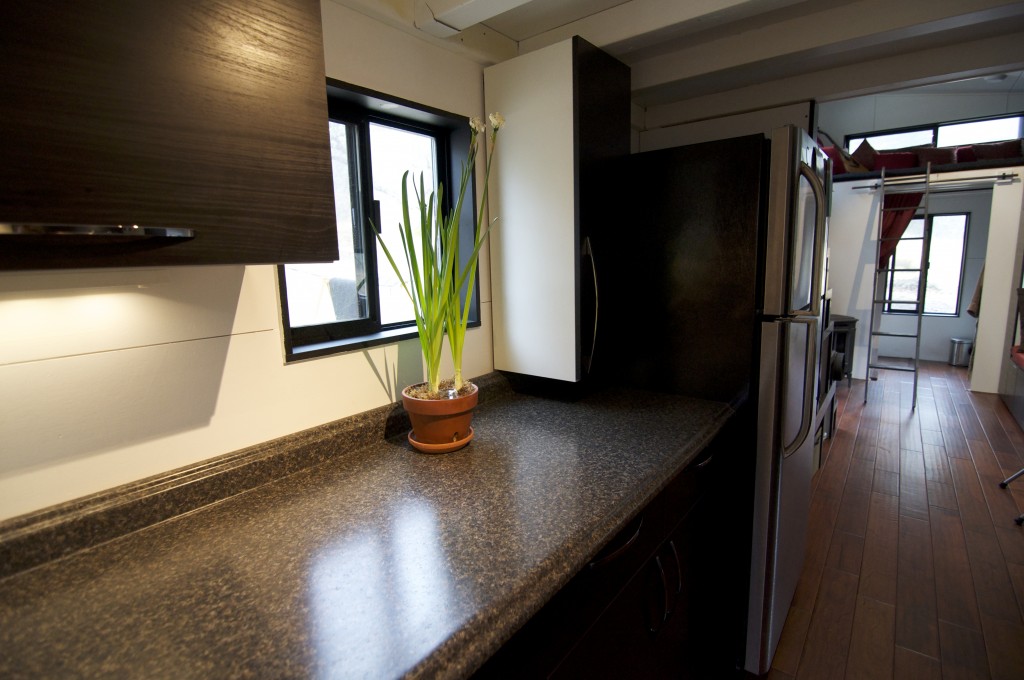
Final Question Round!
26. Any parting advice for Hobo readers?
My main advice to anyone wanting to go tiny is for them to be honest with who they are and what they want. And the best way to get really clear on those pieces is to “unplug” from western civilization for a little while by going camping, spending time in nature, going to Baja, etc.
Anything that will allow one to see who they are without the normal interferences of day-to-day life.
The other tip I would have is that one doesn’t need to know exactly what the process will look like before they start moving towards their dream. The important part is just to start. Even if it seems to be with a tiny, tiny step. As long as one keeps taking those steps, in time, they will also end up waking up in their dream tiny house someday.
27. Is there anyone you’d like to give a shout out to, thank, or plug?
We are forever grateful to Kent Griswold at Tiny House Blog as he is the one that introduced us to tiny house living. He has remained a friend all along and encouraged us every step of the way.
28. Where can Hobo readers find you online?
We can be found on our Tiny House Build website, and on Facebook.
Thank you!
Gabriella and Andrew’s advice really resonated with me, and I hope it did for you as well. I figured I would go full circle, and make my first interview with the couple that architected the first Tiny House I fell in love with in my very first post. They’ve been a strong influence not only in terms of my own personal direction, but also in terms of where this blog will go in the future.
Living in South East Asia for the past year has really opened me up to seeing inside myself, what I need from life, and what I want to accomplish with the time I have. It’s an incredibly liberating feeling that is as strong as it is hard to articulate.
I’ve only been into the Tiny House movement for about 2 weeks, and I’ve been swept away by it. I really admire their resolve to go off-grid as well.
For me, going Tiny is all about sustainability, less frivolous consumption, reducing the toll my body takes on the planet, and enhancing my ability to live a meaningful life of travel, inspiring others, and being inspired.
I’ve got another interview up my sleeve, so stay tuned for more advice from great Tiny House people.
Down the line, in addition to my own musings and thoughts on society, life, technology, and so on, I also look forward to jumping head first into writing about survival prepping, digital nomadism, and off-grid living.
View photos and a video tour of the Morrison’s Tiny Home
Thanks for reading, and please be sure to leave a comment below!




